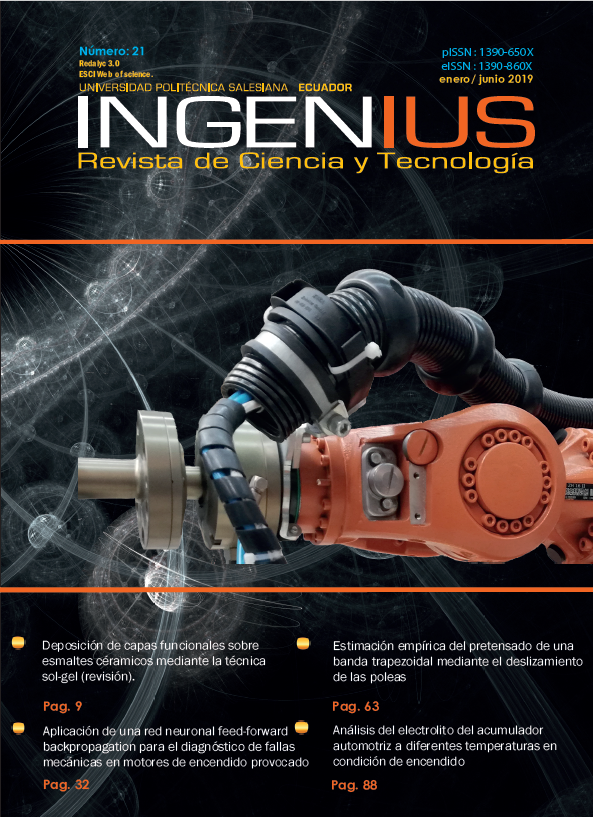Empirical Estimation of the Prestressed of a V-Belt Through the Slip of the Pulleys
Main Article Content
Abstract
Article Details
The Universidad Politécnica Salesiana of Ecuador preserves the copyrights of the published works and will favor the reuse of the works. The works are published in the electronic edition of the journal under a Creative Commons Attribution/Noncommercial-No Derivative Works 4.0 Ecuador license: they can be copied, used, disseminated, transmitted and publicly displayed.
The undersigned author partially transfers the copyrights of this work to the Universidad Politécnica Salesiana of Ecuador for printed editions.
It is also stated that they have respected the ethical principles of research and are free from any conflict of interest. The author(s) certify that this work has not been published, nor is it under consideration for publication in any other journal or editorial work.
The author (s) are responsible for their content and have contributed to the conception, design and completion of the work, analysis and interpretation of data, and to have participated in the writing of the text and its revisions, as well as in the approval of the version which is finally referred to as an attachment.
References
[2] A. J. Nieto Quijorna, Elementos de máquinas. Área de Ingeniería Mecánica, Universidad de Castilla-La Mancha, España, 2007. [Online]. Available: https://goo.gl/4wkZpd
[3] Budynas, R. G, N. J. Keith, and J. E. Shigley, Mechanical Engineering Design. McGraw-Hill Education, New York, USA, 2015. [Online]. Available: https://goo.gl/1TivVq
[4] R. L. Mott, Diseño de elementos de máquinas. Pearson Education„ 2006. [Online]. Available: https://goo.gl/buKXz3
[5] R. C. Juvinall, Diseño de elementos de máquinas. Limusa Wiley, 2013. [Online]. Available: https://goo.gl/xtrD3K
[6] V. B. Bhandari, Design of Machine Elements. McGraw-Hill Education, India, 2016.
[7] A. D. Almeida and S. Greenberg, “Technology assessment: energy-efficient belt transmissions,” Energy and Buildings, vol. 22, no. 3, pp. 245–253, 1995. [Online]. Available: https://doi.org/10.1016/0378-7788(95)00926-O
[8] C. A. Silva, M.-A. Andrianoely, L. Manin, S. Ayasamy, C. Santini, E. Besnier, and D. Remond, “Optimization of power losses in poly-v belt transmissions via genetic algorithm and dynamic programming,” Mechanism and Machine Theory, vol. 128, pp. 169–190, 2018. [Online]. Available: https://doi.org/10.1016/j.mechmachtheory.2018.05.016
[9] O. Reynolds, “On the efficiency of belts or straps as communicators of work,” Journal of the Franklin Institute, vol. 99, no. 2, pp. 142–145, 1875. [Online]. Available: https://doi.org/10.1016/0016-0032(75)90662-6
[10] G. Gerbert, “A note on slip in v-belt drives,” Journal of Engineering for Industry, vol. 98, no. 4, pp. 1366–1368, 1976. [Online]. Available: https://doi.org/10.1115/1.3439115
[11] ——, “Paper xii (i) on flat belt slip,” in Vehicle Tribology, ser. Tribology Series, D. Dowson, C. Taylor, and M. Godet, Eds. Elsevier, 1991, vol. 18, pp. 333–340. [Online]. Available: https://doi.org/10.1016/S0167-8922(08)70149-4
[12] ——, “Belt slip-a unified approach,” Journal of Mechanical Design, vol. 118, no. 3, pp. 432–438, 1996. [Online]. Available: https://doi.org/10.1115/1.2826904
[13] H. Belofsky, “On the theory of power transmission by v-belts,” Wear, vol. 39, no. 2, pp. 263–275, 1976. [Online]. Available: https://doi.org/10.1016/0043-1648(76)90054-5
[14] T. H. C. Childs and D. Cowburn, “Power transmission losses in v-belt drives part 2: Effects of small pulley radii,” Proceedings of the Institution of Mechanical Engineers, Part D: Transport Engineering, vol. 201, no. 1, pp. 41–53, 1987. [Online]. Available: https://doi.org/10.1243/PIME_PROC_1987_201_156_02
[15] W.-H. Chen and C.-J. Shieh, “On angular speed loss analysis of flat belt transmission system by finite element method,” International Journal of Computational Engineering Science, vol. 04, no. 01, pp. 1–18, 2003. [Online]. Available: https://doi.org/10.1142/S1465876303000752
[16] B. Balta, F. O. Sonmez, and A. Cengiz, “Speed losses in v-ribbed belt drives,” Mechanism and Machine Theory, vol. 86, pp. 1–14, 2015. [Online]. Available: https://doi.org/10.1016/j.mechmachtheory.2014.11.016
[17] G. Cepon, L. Manin, and M. Boltežar, “Experimental identification of the contact parameters between a v-ribbed belt and a pulley,” Mechanism and Machine Theory, vol. 45, no. 10, pp. 1424–1433, 2010. [Online]. Available: https://doi.org/10.1016/j.mechmachtheory.2010.05.006
[18] L. Bertini, L. Carmignani, and F. Frendo, “Analytical model for the power losses in rubber v-belt continuously variable transmission (cvt),” Mechanism and Machine Theory, vol. 78, pp. 289–306, 2014. [Online]. Available: https://doi.org/10.1016/j.mechmachtheory.2014.03.016
[19] Optibelt, “Manual técnico para transmisiones por correas trapeciales,” Optibelt Power Transmission, Tech. Rep., 2008.
[20] Gates, “Mantenimiento preventivo de correas y transmisiones,” Gates Corporation, Tech. Rep., 2009.
[21] E. Hernández, B. Angulo, P. Fiallos, and V. Chávez, “Método para el cálculo del costo de la indisponibilidad en procesos productivos,” Perfiles,, vol. 1, pp. 90–98, 2017.
[22] M. F. Triola, Estadística. Pearson Education, 2013. [Online]. Available: https://goo.gl/Zfkisc

